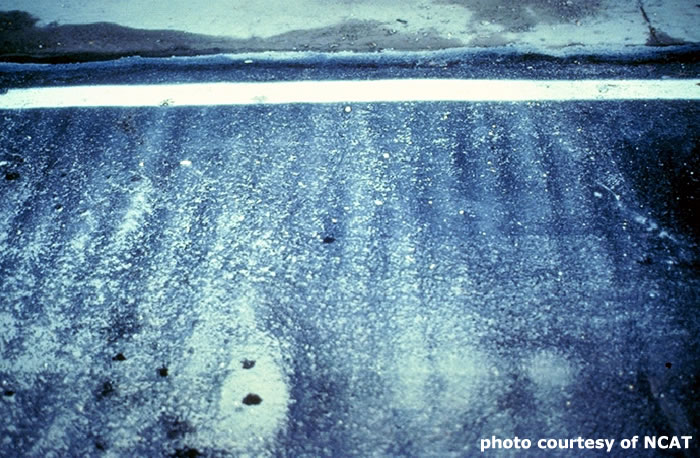Description
Surface waves can appear in several different forms:
- Washboarding. Small waves generally about 75 – 100 mm (3 – 4 inches) apart.
- Short waves (also called ripples or auger shadows). Generally about 0.3 – 0.9 m (1 – 3 ft) apart with 0.45 – 0.60 m (1.5 – 2 ft) being the most common separation.
- Long waves. Generally farther apart than short waves. Can be in excess of 30 m (100 ft) apart.

Problem
All surface waves will cause an increase in roughness. The pavement’s structural capacity is only affected if the waves are severe enough to cause vehicles to bounce significantly as the traverse the waves. This would increase impact loading and thus increase the overall loading to which the pavement is subjected.
Possible Causes
Causes can be roughly categorized by the type of surface wave:
- Washboarding. Improper operation of a vibratory roller. Generally, excessive roller speeds, low vibratory frequencies or excessive vibratory amplitudes for a given pavement thickness can lead to washboarding.
- Short waves. Causes can are numerous but most relate to items that can cause frequent or periodic changes in the screed angle of attack, and corresponding changes in mat thickness. Likely causes include:
- Fluctuation of material head in front of the paver screed. As the material head changes, the screed angle and elevation will change. This fluctuating head can be caused by excessive auger starts and stops or an improperly set material feed rate. Fluctuations may cause either short waves or non-uniform texture.
- Screed in poor mechanical condition. Screeds with excessive play in their controls may fluctuate slightly around the equilibrium screed angle.
- Unresponsive screed. Extremely high paver speeds, in excess of 25 m (83 ft) per minute for thin lifts or more than 15 m (50 ft) per minute for thick lifts (more than 62.5 mm (2.5 inches) thick), can cause to screed to be relatively unresponsive.
- Improper mounting, operation or sensitivity of the automatic screed control system. If the screed control system is improperly mounted, operated, or it is too sensitive it could supply a fluctuating grade reference causing the screed to fluctuate in response.
- Truck driver applying the breaks too hard while being pushed by the paver. If break application is too much the paver tracks or wheels may slip, which will cause a change in material head in front of the screed.
- Improper mix design. Mixtures whose stiffness is extremely sensitive to temperature of composition may compact differentially. Tender mixes may shove and displace as they are compacted.
- Long waves. Causes can be numerous and involve truck, paver and roller operation. Likely causes include:
- Fluctuation of material head in front of the paver screed. If the problem as described under “short waves” occurs over a longer time interval it can result in long waves.
- Screed in poor mechanical condition. Screeds with excessive play in their controls may fluctuate slightly around the equilibrium screed angle.
- Improper mounting or operation of the automatic screed control system. If the grade control system is improperly mounted or operated it could supply a slowly changing grade reference causing the screed angle to slowly change in response. If a stringline is used, sagging between support posts can cause long waves.
- Improper mix design. Mixtures whose stiffness is extremely sensitive to temperature of composition may compact differentially. Tender mixes may shove and displace as they are compacted.
- Emptying the paver hopper between truck loads. This can be caused by improperly adjusted hopper flow gates or poor operating practices. As the material is emptied and there is none to replace it in front of the screed, the material head in front of the screed will decrease.
- Compaction equipment operation. Direction reversals, especially on lifts that are quite thick in relation to nominal maximum aggregate size, can leave bow waves in place at the point of direction reversal. Abrupt roller turns can also cause mix shoving.
- Segregation.
- Temperature differentials.
Solutions
Surface waves can only be eliminated by preventing their formation.
- Washboarding. Decreasing vibratory amplitude, increasing frequency or slowing roller speed will likely eliminate washboarding.
- Short waves. Because there are so many different causes, solutions vary widely. Most importantly, the amount of mix in front of the screed should be kept constant, which implies that slat conveyors and augers should be run at a near constant rate and as close to 100% of the time as possible. Material flow to should be controlled by the hopper flow gates as much as possible. Screed control problems can be identified by turning off the grade control device and determining whether or not the short waves continue. Most other solutions involve strict and careful compliance with established best practices.
- Long waves. Same solutions as short waves.
